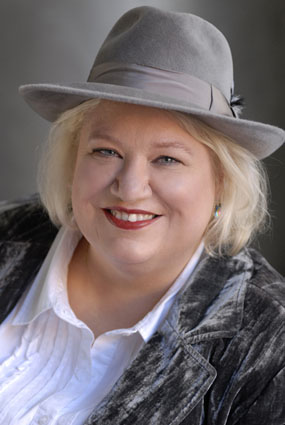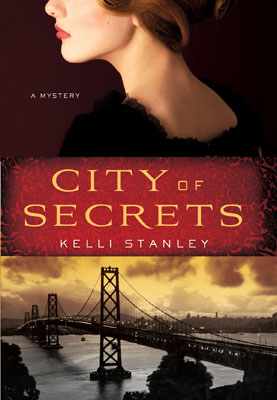The Women Behind Miranda Corbie by Kelli Stanley
 I’m sometimes asked if Miranda Corbie—my hardboiled, fearless, angry, feminine and supremely moral PI—is anachronistic.
I’m sometimes asked if Miranda Corbie—my hardboiled, fearless, angry, feminine and supremely moral PI—is anachronistic.
After all, Miranda swears (profusely); drinks whiskey (often) and smokes (constantly). She became an escort in San Francisco after the loss of her lover in the Spanish Civil War, a conflict in which she fought as a volunteer nurse. Such sexual freedom and frankness—and the way in which Miranda uses her beauty and physical allure—makes her a femme fatale in the role of a gumshoe, and to some people her strength, resilience and attitudes about social justice have raised the question of whether or not she is a woman of her time.
The short answer is: of course. Iconic characters represent their own time and place and setting as well as universal human experiences and feelings that transcend any era. Like her brothers in gumshoes Sam Spade and Philip Marlowe, I hope Miranda proves to be a long-lasting icon, one that speaks to 1940, 2011, and the future.
The long answer is that Miranda is a woman of her time and all time … but because of American attitudes toward history—particularly the romanticized golden years of the Greatest Generation—and because of the way we generally form our opinion of that era—classic film—the image of a strong, independent woman with a social conscience may seem more modern than it is. Especially if you believe that people never had sex before marriage, that profanity was an invention of the 1960s, and that married couples always slept in two separate beds.
Such was the inheritance of the Hays Code, the Hollywood censorship bureau responsible for the sanitized and wholly unreal depiction of the world from 1934 to the late 1950s.This is the past with which we are arguably most familiar—a past that never really existed.
For an eye-opening look at what might have been, check out a pre-code movie like “Baby Face”, which is far franker in dealing with sex (particularly sex as a woman’s primary tool for making something of herself) than any Hollywood film until the ‘60s.
So, what about Miranda? Well, she’s her own person and completely unique, but she shares some things in common with a few real-life women from her era. She may look like Rita Hayworth—and she was partially inspired by Hayworth’s jaw-dropping, iconic performance in Gilda—but her coolness under fire and her passion for social justice are reminiscent of Martha Gellhorn.
Gellhorn was known as a crackerjack, intrepid reporter—considered by many to be one of the greatest war correspondents of the century. She covered the Spanish Civil War and World War Two, fighting vociferously in print against fascism, anti-Semitism and racism throughout her long life. She also smoked, drank, and swore like a sailor. Gellhorn was also considered a great beauty (Nicole Kidman portrays her in an upcoming biopic) and did NOT wish to be remembered as Ernest Hemingway’s third wife.
 Another woman in the Hemingway circle also played a role in shaping Miranda. Marlene Dietrich, the great, glamorous icon of worldly sophistication and seduction, was a good friend to Papa. Today, Dietrich is perhaps best remembered as an incomparable star, a woman who defined reinvention long before Madonna patented the formula. She was, however, much more … a woman who embodied the socially progressive era of the Weimar Republic in 1920s Berlin, a woman who challenged preconceived notions of gender and femininity.
Another woman in the Hemingway circle also played a role in shaping Miranda. Marlene Dietrich, the great, glamorous icon of worldly sophistication and seduction, was a good friend to Papa. Today, Dietrich is perhaps best remembered as an incomparable star, a woman who defined reinvention long before Madonna patented the formula. She was, however, much more … a woman who embodied the socially progressive era of the Weimar Republic in 1920s Berlin, a woman who challenged preconceived notions of gender and femininity.
Ultimately, though, Dietrich’s greatest role was as patriot.
She loathed the Nazis, rebuffed frequent overtures and promises of money and power, and became an American citizen. Recruited by the O.S.S. for secret broadcasts to Germany, she traveled with front-line soldiers in the European theater, suffering hunger, dysentery, frost bite and plenty of near misses. More than any other entertainer, Dietrich *was* a soldier—both a fellow fighter and the girl or mother he’d want to talk to. She was later awarded the Presidential Medal of Freedom for her work. She looked upon the war with the same sensibility as the men who fought it, and regarded it as the most important achievement of her life.
Miranda, too, has a battle to fight. And, like Dietrich, she’s a good soldier. In CITY OF SECRETS, Pandora Blake has been stabbed to death on the World’s Fair Gayway, an anti-Semitic epithet scrawled in blood on her white skin. Miranda confronts American fascism and American eugenics head on, untangling threads that lead her from Treasure Island to Napa Valley to a brutal killer of Jewish women in San Francisco.
It’s a battle Martha Gellhorn would write about and Dietrich would fight in.
A battle Miranda will have to win alone.
Thanks for reading, and to Elizabeth for hosting me! I hope you’ve enjoyed learning more about Miranda … and a few of the real women who stand behind her.
City of Secrets is available from Minotaur Books (ISBN: 978-0312603618).









Pingback : The weekly web ramble (9/16)
“…hardboiled, fearless, angry, feminine…”
Sounds like my kind of lady! 😉
Wow, I had never heard of the Hays Code before. I will certainly look at movies from that time frame a little differently the next time I see them. Great post. Look forward to making Miranda’s acquaintance.
I’m very excited to read this!
Thank you so much, Sabrina! 🙂 I hope you enjoy meeting Miranda!!
Excellent post, Kelli. I’m ashamed to admit that this series is new to me, but am happy to be adding these books to my TBR pile.